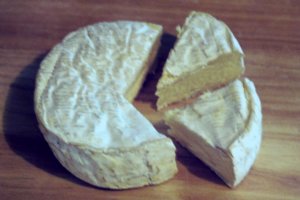(AOC since 1983)

A Camembert
Description
| Type | Flowered rind cheese. |
| Milk | Cow. Whole milk. |
| Aspect | Cylinder (11 cm diameter, 3 cm thick).
250 gr. 45% of fat. Thin white down rind, that may be covered with very little red dots. |
| Region | Camembert - Vimoutiers - Auge country- Normandy |
History
The legend explains that the Camembert was created by Marie Harel in 1791 during the French Revolution, helped by a hiding priest from the Brie country side. It soon became the most famous cheese of Normandy and made the fortune of many dairies in the Auge country.
Sponsored by Napoléon III, and equipped with a poplar wood box at the end of the XIX century and a famous label, it was sent to Paris, in the east of France and all over Europe where it was soon copied.
It has also often been associated with the beret and the baguette of bread ... as one of the supposed symbols of the French people.This is in part due to the fact that the Camembert cheese met rendezvous of history during World War I (1914-18) when it was one of the components of the iron rations given to French soldiers.
Making
- First, whole milk is poured into large containers called "bassines normandes" (Norman bowls). The aim of that stage is to make the milk coagulate/curdle. In conditions that are different in every dairy, the rennet* is added to the milk, and 1h30 should be allowed to pass before the beginning of the next step. At the end of that period, the milk has formed into curds.
*Rennet is an enzyme that reduces the time necessary to separate the liquids from the solids. - Then comes the moulding. This is particular to Camembert, because the curdled milk should be put into the mould with a special ladle, in at least four phases (that operation often lasts more than four hours!). Extreme caution should be taken to prevent the curds from being shaken.
- The next step is rather easy in comparison: the curds are perfectly levelled in the mould.
- To drain off whey, the future Camembert is put on shelves, for four to five hours and then turned over.
- The next morning, the Camembert, which now has its final shape, is taken out of its mould, and set on a tray in a salting room. There it is covered on both sides with a thin layer of salt and finally with a precious fungus "penicillium candidum".
- The active part of the making is now over ... Nevertheless, the camembert is not yet ready for consumption. It should be placed on special shelves "les haloirs" for approximately twelve days .
- Finally it is packed into its famous wood box, and sent to the consumers.
- After 21 days, it is said to be "affiné" (refined) and "à point" 30 to 35 days after its birth.
Variations
You may also find Camembert cheeses matured with cider or "Camembert hearts with Calvados". The first ones are based on young Camembert steeped into cider, while the second ones on unripened Camembert steeped in Calvados brandy.
Links, addresses and information
On the web
The Camembert Web Pages. By the same author - everything about Camembert cheese.
The village of Camembert. Learn more about the village of Camembert...
Camembert-AOCThe official web site of the AOC camembert.
Fromagerie Reaux A Norman dairy that has a nice web site.
Books
"Le Camembert, mythe national" de P.Boisard
Calman Lévy, Paris, 1992
"Le Camembert, histoire, fabrication, terroir, recettes" de B.Goffi
Rustica Editions,Paris, 1999
ISBN 2-84038-267-9
Museums
La Maison du Camembert
61120 Camembert
Tél: +33 (0)2 33 39 43 35
Musée du Camembert
61120 Vimoutiers
Conservatoire des Techniques Fromagères
Abbaye de Saint-Pierre-sur-Dives
14170 Saint Pierre-sur-Dives
Organisations et producteurs
Syndicat Normand des Fabricants de Camembert
82, rue Bernières
14300 Caen
Tel: +33 (0)2 31 85 50 93
